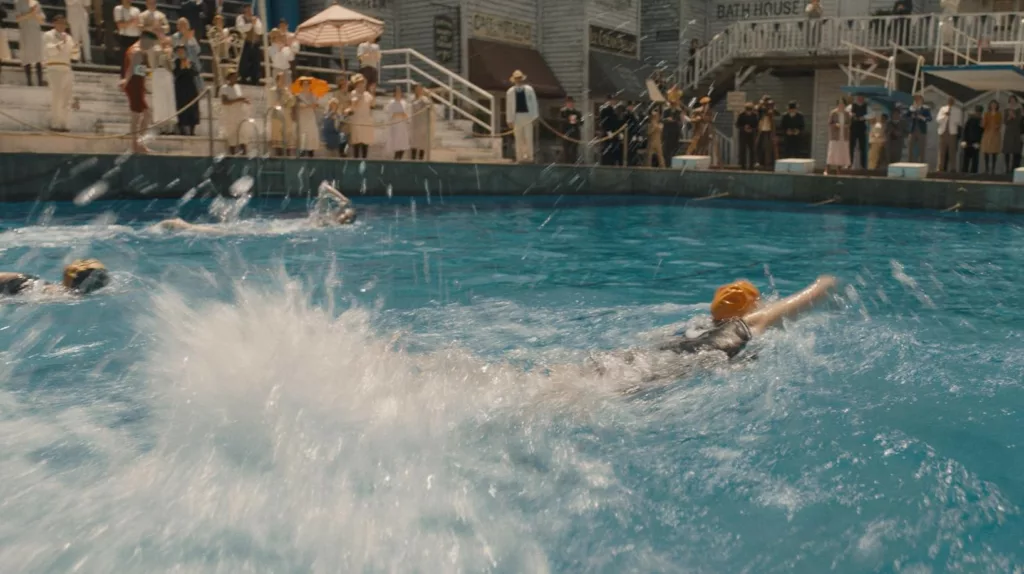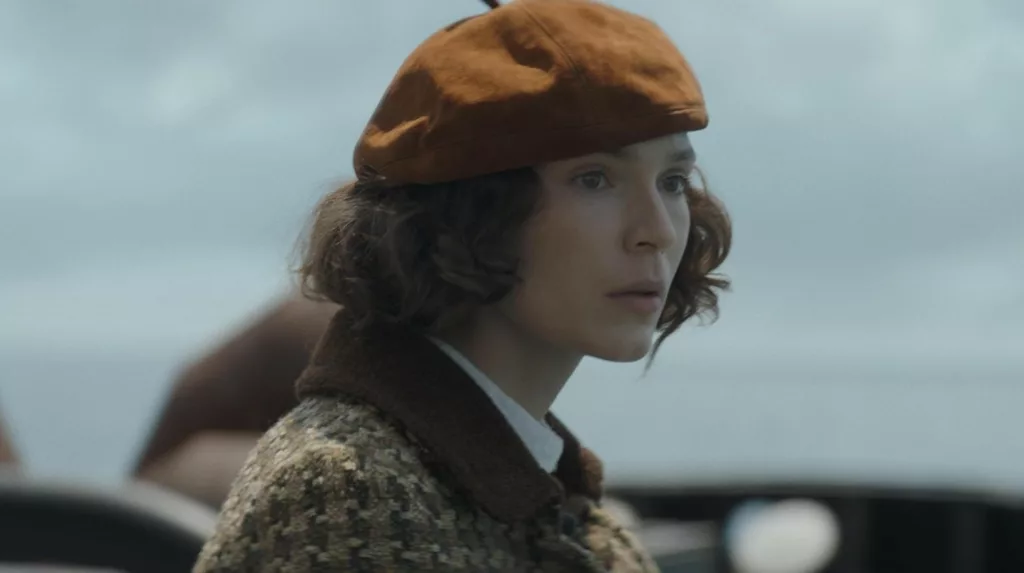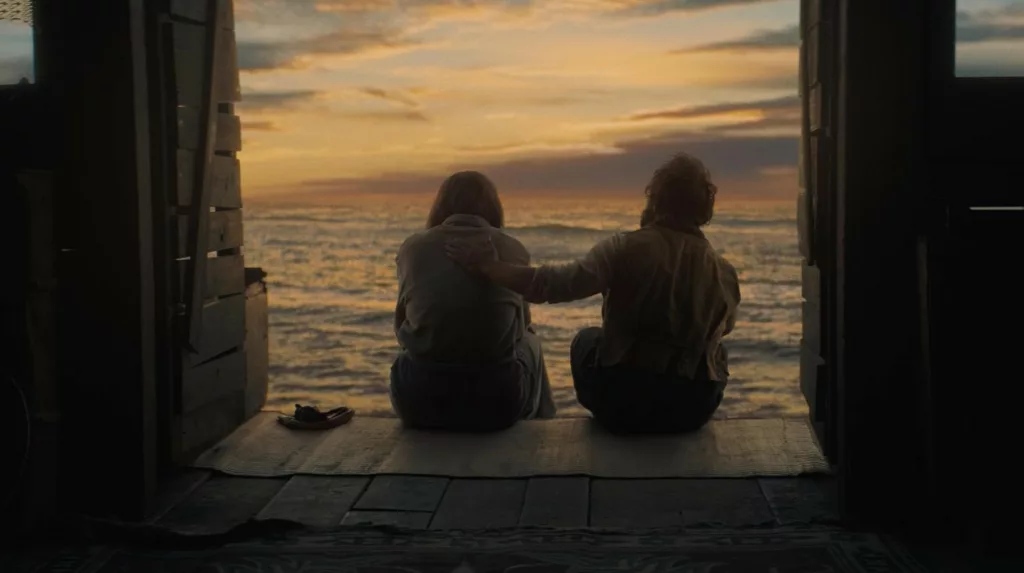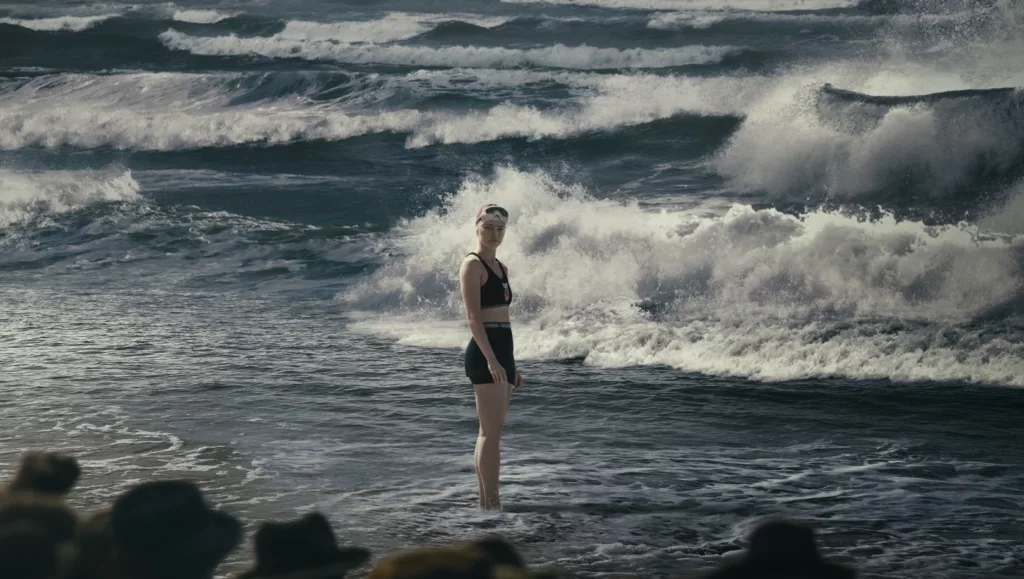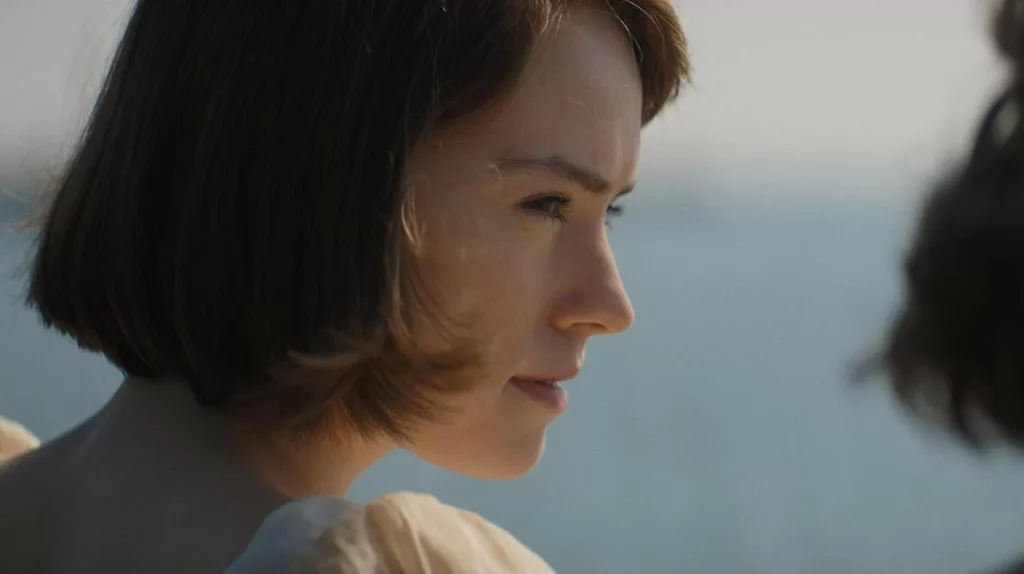The 1926 heroine Gertrude “Trudy” Ederle is brought to the big screen once more in Joachim Rønning’s Young Woman and the Sea. Known for swashbuckling adventures like Pirates of the Caribbean: Dead Men Tell No Tales, Norwegian director Rønning faces a new type of challenge telling Ederle’s true tale of bravery. Against all odds, Ederle became the first woman to power through treacherous tides and swim the 21 mile Strait of Dover separating England and France.
Played with grit and grace by Star Wars’ Daisy Ridley, Trudy grows up dreaming of the open water despite life-threatening illness and pressure steering her to more “womanly” pursuits on dry land. Through talent and tenacity, she rises from childhood swims off Coney Island pier to representing America at the Olympics.
But Trudy has her eyes on a goal much greater than gold medals – to conquer the English Channel. In recounting how one New Yorker’s defiance of expectations rippled across the globe, Young Woman and the Sea inspiringly pays tribute to the trails Ederle blazed. While sticking close to the surface of her story at times, the film ensures history will not forget this watersport wonder who proved women owned the waves.
Trudy Ederle’s Champion Spirit
Gertrude “Trudy” Ederle was born in 1905 in the bustling Coney Island neighborhood of New York City. Her German immigrant parents, Henry and Gertrude, worked hard to provide for their children despite their humble means. As a young girl, Trudy nearly lost her life to measles but showed fierce determination in her recovery. This early bout with illness may have sparked the competitive fire within her.
Along with her sister Meg, Trudy grew up loving the water but faced barriers due to her gender. Their mother, Gertrude, wanted both girls to learn to swim after a tragic ferry accident took many female lives. With their father’s reluctance, the sisters took diverting routes to practice: Meg in organized teams, Trudy lonelier in the rough surf. Though the future swimming star grew partially deaf from her illness, nothing could diminish Trudy’s passion to better herself in the waves.
Under the tutelage of no-nonsense coach Charlotte Epstein, Trudy proved herself the best on a newly formed women’s team. She thrived in competitions, breaking records across New York State. Meanwhile, Meg, older by a few years, accepted the traditional path of an arranged marriage. The sisters remained forever close, however, supporting each other regardless of their different journeys.
By 1924, Trudy had accomplished enough to try out for the national team headed to the Paris Olympics. There she triumphed together with her teammates while routinely facing skepticism from the male administrators in charge. They scorned women’s participation as mere novelty acts. Undeterred, Trudy set her eyes on an even loftier target: becoming the first woman to conquer the treacherous English Channel. Her striking six would inspire the world.
Empowered by the Sea
Gertrude “Trudy” Ederle’s story in Young Woman and the Sea is one of ambitious pursuit in the face of societal limitations and personal doubt. Through her swim across the treacherous English Channel, Ederle challenged conceptions of what women could achieve athletically.
In 1920s America, the norms that barred women from many sports still held influence. Ederle started her competitive career facing resistance, deemed too frail after a childhood illness and too feminine for such an undertaking. Though gifted in the water, the doors were slow to open for her. The film showcases the blatant sexism she encountered from those unwilling to reconsider preconceived gender roles, with even mentors showing jealousy of her talent.
Rather than dwell on oppression, the film keeps its focus on Ederle’s drive to succeed through her own abilities. In her rise from winning local races to representing her nation, she let her accomplishments prove doubters wrong. While the realities of the period were part of her story, the thematic emphasis is on the power of inner strength and vision to transcend external limitations. Ederle seemed to find empowerment most fully not on land but in navigating the waves, the sea mirroring her refusal to be restrained.
The film could have emphasized how Ederle motivated future swimmers more subtly than through an overt declaration. But ultimately, it conveys how one pioneering woman shook assumptions about her era. Young Woman and the Sea shares an inspiring message that, when supported from within, individual talents can alter what seems set in society and redefine what a person belongs to. In Ederle, it portrayed determination, transforming a personal passion into a feat still acclaimed.
Inspired by the Sea: Crafting Trudy Ederle’s Story
Swimming scenes are where Young Woman and the Sea truly come alive. Director Joachim Rønning clearly revels in capturing the beauty and danger of open water. Scenes of Trudy gliding through the sea are visually stunning, putting viewers right there in the aqueous arena with her. Oscar Faura’s shimmering cinematography transports us beneath the ocean surface, conveying both its allure and hazards.
Shooting on location only enhanced the realism. Audiences feel the swell of choppy waves and the sting of saltwater. Production designs and costumes further immersed viewers, helping transport them back to early 20th-century America. We appreciate the hardships of Trudy’s time while celebrating how far we’ve come.
Rønning faced a balancing act in his direction. He honors the adversity Trudy faced but avoids dwelling in the darkness. An undercurrent of optimism remains. We root for Trudy not just because she’s disadvantaged but because of her spirit and work ethic. Her story uplifts without sugarcoating the challenges. Complex themes of gender equality and personal fulfillment are woven in seamlessly.
By crafting a tale that entertains while informing, Rønning has ensured Trudy Ederle’s story will continue to inspire new audiences. His passionate direction does justice to this trailblazing woman’s awe-inspiring determination to let nothing stop her from achieving her dreams, not even the sea itself.
Daisy Ridley’s Determined Swim
Daisy Ridley brings Trudy Ederle’s steady determination to life in Young Woman and the Sea. From her early efforts learning to swim despite obstacles to striving for her chance in competitive races, Ridley conveys Ederle’s quiet but unbending spirit.
We feel her passion through her subtle expressions and the power of her physical performance in the water. When faced with doubters trying to hold her back, a playful spark enters Ridley’s eyes, as if challenging the waves ahead.
Particularly moving are the scenes where Ridley shares the screen with Tilda Cobham-Hervey as Ederle’s sister Margaret. Their natural sisterly rapport anchors the heart of the film. While Margaret resigns to the expectations of their time and gets married, we understand Ederle’s drive to continue chasing her dreams through their bond. Some of the tenderest moments come from their conspiring over Trudy’s insufferable date or Margaret’s support of her sister’s history-making plans.
Among the supporting players, Jeanette Hain stands out as their no-nonsense mother, who instills the sisters’ strength. Hain brings humor and spirit to the role. Stephen Graham also leaves an impression through his eccentric but inspring coach Burgess, conveying a playful spark when paired with Ridley that helps unlock new layers of Ederle’s rebellious determination. Overall, it’s Ridley’s committed, leading performance that carries us along on Ederle’s journey.
Crossing the Channel
Trudy Ederle’s determination to succeed against the odds makes for some of the most engrossing scenes in Young Woman and the Sea. Director Joachim Rønning allows key moments, like Ederle’s first public race, to unfold in real time. We experience the raw thrill of her gaining stride by stride on the competition. In these pure stretches of fluid storytelling, Ederle’s talent and relentlessness shine through.
Later, her attempts to cross the English Channel create authentic suspense. Braving treacherous currents and nighttime swims alone, we understand the physical and emotional toll such an endeavor requires. Rønning uses expansive shots of the open water to put us right there with Ederle as she strives toward her monumental goal. The uncertainties of endurance and weather over such a long distance keep viewers on edge.
Undoubtedly, the film aims to uplift and inspire through Ederle’s example of chasing dreams dismissed as impossible. Her story reminds us that women, then as now, have long faced doubters trying to limit their ambitions. Ederle’s perseverance in the face of adversity remains deeply moving.
At the same time, some critiques ring true. The screenplay and direction could perhaps have probed Ederle’s inner resilience further. What motivated her beyond just proving naysayers wrong? A glimpse into her psychology may have added resonance. Her sister’s arranged marriage also feels a tad overly dramatic.
Still, Young Woman and the Sea conveys the wind in Ederle’s sails that carried her past barriers. Rønning navigates some of the most pivotal moments with real flair. Ederle’s monumental swim endures as a landmark of persistence against the tide of prejudice.
Trudy’s Triumph
The story of Trudy Ederle is one that deserves to be shared. While Young Woman and the Sea sticks closely to the traditional biopic formula, it successfully honors the determination and bravery of its real-life heroine. Through Daisy Ridley’s engaging portrayal, Ederle comes alive as a woman who refused to let challenges stand in the way of her dreams. She faced considerable barriers due to the biases of her time, yet persisted through sheer will and love of the sport.
The film efficiently chronicles Ederle’s journey from a childhood illness to Olympic medals and her historic swim across the English Channel. Director Joachim Rønning builds excitement during the climactic channel-crossing scenes.
Yet at times, the story feels a bit tidy, leaving one wondering about the fuller person behind the icon. Still, the movie accomplishes its chief goal by shining a well-deserved new light on Ederle’s remarkable accomplishments. Her story of using adversity as fuel while inspiring future generations deserves even wider recognition.
Overall, while not entirely revelatory, Young Woman and the Sea makes for an enjoyable film celebrating female empowerment and sports history. Ederle’s indomitable spirit and place in challenging expectations of her era are portrayed in a way that can fire imaginations young and old. Her watery triumph is one worthy of ongoing memory.
The Review
Young Woman and the Sea
While not fully dimensional, Young Woman and the Sea succeeds at honoring the pioneering achievements of Trudy Ederle through an engaging portrayal. Ederle's story of determination in the face of immense societal opposition deserves celebration and can continue to encourage future generations.
PROS
- Accurately depicts the many obstacles Ederle faced as a female athlete.
- Features strong performances from Daisy Ridley and Tilda Cobham-Hervey.
- Effectively builds suspense during Ederle's channel-crossing scenes.
- Spreads awareness of Ederle's inspirational story of female empowerment
CONS
- Formulaic biopic structure leaves character somewhat one-dimensional.
- Fails to fully probe Ederle's inner drive and psychology
- Overuses score to underscore emotion instead of letting scenes stand on their own
- Reliance on tropes like the plucky child limits dramatic potential.









































